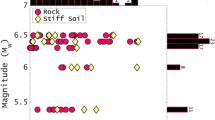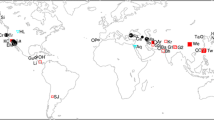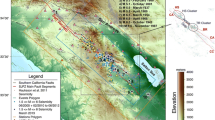Abstract
This article presents the latest generation of ground-motion models for the prediction of elastic response (pseudo-) spectral accelerations, as well as peak ground acceleration and velocity, derived using pan-European databases. The models present a number of novelties with respect to previous generations of models (Ambraseys et al. in Earthq Eng Struct Dyn 25:371–400, 1996, Bull Earthq Eng 3:1–53, 2005; Bommer et al. in Bull Earthq Eng 1:171–203, 2003; Akkar and Bommer in Seismol Res Lett 81:195–206, 2010), namely: inclusion of a nonlinear site amplification function that is a function of \(\text{ V }_\mathrm{S30}\) and reference peak ground acceleration on rock; extension of the magnitude range of applicability of the model down to \(\text{ M }_\mathrm{w}\) 4; extension of the distance range of applicability out to 200 km; extension to shorter and longer periods (down to 0.01 s and up to 4 s); and consistent models for both point-source (epicentral, \(\text{ R }_\mathrm{epi}\), and hypocentral distance, \(\text{ R }_\mathrm{hyp}\)) and finite-fault (distance to the surface projection of the rupture, \(\text{ R }_\mathrm{JB}\)) distance metrics. In addition, data from more than 1.5 times as many earthquakes, compared to previous pan-European models, have been used, leading to regressions based on approximately twice as many records in total. The metadata of these records have been carefully compiled and reappraised in recent European projects. These improvements lead to more robust ground-motion prediction equations than have previously been published for shallow (focal depths less than 30 km) crustal earthquakes in Europe and the Middle East. We conclude with suggestions for the application of the equations to seismic hazard assessments in Europe and the Middle East within a logic-tree framework to capture epistemic uncertainty.













Similar content being viewed by others
Notes
References
Abrahamson NA, Silva W (2008) Summary of the Abrahamson and Silva NGA ground-motion relations. Earthq Spectra 24:67–97
Abrahamson NA, Youngs RR (1992) A stable algorithm for regression analyses using the random effects model. Bull Seismol Soc Am 82:505–510
Akkar S, Bommer JJ (2006) Influence of long-period filter cut-off on elastic spectral displacements. Earthq Eng Struct Dyn 35:1145–1165
Akkar S, Bommer JJ (2007a) Prediction of elastic displacement response spectra at multiple damping levels in Europe and the Middle East. Earthq Eng Struct Dyn 36:1275–1301
Akkar S, Bommer JJ (2007b) Empirical prediction equations for peak ground velocity derived from strong-motions records from Europe and the Middle East. Bull Seismol Soc Am 97:511–530
Akkar S, Bommer JJ (2010) Empirical equations for the prediction of PGA, PGV and spectral accelerations in Europe, the Mediterranean and the Middle East. Seismol Res Lett 81:195–206
Akkar S, Çağnan Z (2010) A local ground-motion predictive model for Turkey, and its comparison with other regional and global ground-motion. Bull Seismol Soc Am 100:2978–2995
Akkar S, Kale Ö, Yenier E, Bommer JJ (2011) The high-frequency limit of usable response spectral ordinates from filtered analogue and digital strong-motion accelerograms. Earthq Eng Struct Dyn 40:1387–1401
Akkar S, Sandıkkaya MA, Şenyurt M, Azari SA, Ay BÖ (2013) Reference database for seismic ground-motion in Europe (RESORCE). Bull Earthq Eng (submitted to this issue)
Al Atik L, Abrahamson NA, Bommer JJ, Scherbaum F, Cotton F, Kuehn N (2010) The variability of ground-motion prediction models and its components. Seismol Res Lett 81:783–793
Ambraseys NN, Douglas J, Sarma SK, Smit PM (2005) Equations for the estimation of strong ground motion from shallow crustal earthquakes using data from Europe and the Middle East: horizontal peak ground acceleration and spectral acceleration. Bull Earthq Eng 3:1–53
Ambraseys NN, Simpson KA, Bommer JJ (1996) The prediction of horizontal response spectra in Europe. Earthq Eng Struct Dyn 25:371–400
Anderson JG, Hough SE (1984) A model for the shape of the Fourier amplitude spectrum of acceleration at high frequencies. Bull Seismol Soc Am 74:1969–1993
Atkinson GM, Morrison M (2009) Observations on regional variability in ground-motion amplitude for small-to-moderate magnitude earthquakes in North America. Bull Seismol Soc Am 99:2393–2409
Berge-Thierry C, Cotton C, Scotti O, Griot-Pommera D-A, Fukushima Y (2003) New empirical attenuation laws for moderate European earthquakes. J Earthq Eng 7:193–222
Bindi D, Luzi L, Massa M, Pacor F (2010) Horizontal and vertical ground motion prediction equations derived from the Italian Accelerometric Archive (ITACA). Bull Earthq Eng 8:1209–1230
Bommer JJ (2012) The challenge of building logic trees for probabilistic seismic hazard analysis. Earthq Spectra 28:1723–1735
Bommer JJ, Akkar S (2012) Consistent source-to-site distance metrics in ground-motion prediction equations and seismic source models for PSHA. Earthq Spectra 28:1–15
Bommer JJ, Akkar S, Kale Ö (2011) A model for vertical-to-horizontal response spectral ratios for Europe and the Middle East. Bull Seismol Soc Am 101:1783–1806
Bommer JJ, Akkar S, Drouet S (2012) Extending ground-motion prediction equations for spectral ordinates to higher response frequencies. Bull Earthq Eng 10:379–399
Bommer JJ, Alarcón JE (2006) The prediction and use of peak ground velocity. J Earthq Eng 10:1–31
Bommer JJ, Douglas J, Scherbaum F, Cotton F, Bungum H, Fäh D (2010b) On the selection of ground-motion prediction equations for seismic hazard analysis. Seismol Res Lett 81:783–793
Bommer JJ, Douglas J, Strasser FO (2003) Style-of-faulting in ground motion prediction equations. Bull Earthq Eng 1:171–203
Bommer JJ, Scherbaum F (2008) The use and misuse of logic-trees in PSHA. Earthq Spectra 24:997–1009
Bommer JJ, Scherbaum F, Bungum H, Cotton F, Sabetta F, Abrahamson NA (2005) On the use of logic trees for ground-motion prediction equations in seismic hazard assessment. Bull Seismol Soc Am 95:377–389
Bommer JJ, Stafford PJ, Akkar S (2010a) Current empirical ground-motion prediction equations for Europe and their application to Eurocode 8. Bull Earthq Eng 8:5–26
Bommer JJ, Stafford PJ, Alarcón JE, Akkar S (2007) The influence of magnitude range on empirical ground-motion prediction. Bull Seismol Soc Am 97:2152–2170
Boore DM, Atkinson GM (2008) Ground-motion prediction equations for the average horizontal component of PGA, PGV, and 5%-damped PSA at spectral periods between 0.1s and 10.0s. Earthq Spectra 24:99–138
Bozorgnia Y, Abrahamson NA, Campbell KW, Rowshandel B, Shantz T (2012) NGAWest2: a comprehensive research program to update ground motion prediction equations for shallow crustal earthquakes in active tectonic regions. In: Proceedings of 15th world conference on earthquake engineering paper number 2572, Lisbon, Portugal
Campbell KW (2003) Prediction of strong ground motion using the hybrid empirical method and its use in the development of ground-motion (attenuation) relations in eastern North America. Bull Seismol Soc Am 93:1012–1033
Campbell KW, Bozorgnia Y (2008) NGA ground motion model for the geometric mean horizontal component of PGA, PGV, PGD and 5%-damped linear elastic response spectra at periods ranging from 0.1 s to 10.0 s. Earthq Spectra 24:139–171
Cauzzi C, Faccioli E (2008) Broadband (0.05 to 20 s) prediction of displacement response spectra based on worldwide digital records. J Seismol 12:453–475
Comité Européen de Normalisation (CEN) (2004) Eurocode 8, design of structures for earthquake resistance–part 1: general rules, seismic actions and rules for buildings. European Standard NF EN 1998–1, Brussels
Chiou B, Darragh R, Gregor N, Silva W (2008) NGA project strong-motion database. Earthq Spectra 24:23–44
Chiou BS-J, Youngs RR (2008) An NGA model for the average horizontal component of peak ground motion and response spectra. Earthq Spectra 24:173–215
Chiou B, Youngs R, Abrahamson N, Addo K (2010) Ground-motion attenuation model for small-to-moderate shallow crustal earthquakes in California and its implications on regionalization of ground-motion prediction models. Earthq Spectra 26:907–926
Danciu L, Tselentis G-A (2007) Engineering ground-motion parameters attenuation relationships for Greece. Bull Seismol Soc Am 97:162–183
Douglas J (2003) Earthquake ground motion estimation using strong-motion records: a review of equations for the estimation of peak ground acceleration and response spectral ordinates. Earth Sci Rev 61:43–140
Douglas J (2011) Ground-motion prediction equations 1964–2010. Final report BRGM/RP-59356-FR
Douglas J, Boore DM (2011) High-frequency filtering of strong-motion records. Bull Earthq Eng 9:395–409
Douglas J, Bungum H, Scherbaum F (2006) Ground-motion prediction equations for southern Spain and southern Norway obtained using the composite model perspective. J Earthq Eng 10(1):37–72
Douglas J, Halldórsson B (2010) On the use of aftershocks when deriving ground-motion prediction equations. In: Proceedings of the 9th U.S. national and 10th Canadian conference on earthquake engineering, paper no. 220
Douglas J, Jousset P (2011) Modeling the difference in ground-motion magnitude-scaling in small and large earthquakes. Seismol Res Lett 82:504–508
Fukushima Y, Berge-Thierry C, Volant P, Griot-Pommera D-A, Cotton F (2003) Attenuation relation for West Eurasia determined with recent near-fault records from California, Japan and Turkey. J Earthq Eng 7:573–598
Joyner WB, Boore DM (1981) Peak horizontal acceleration and velocity from strong-motion records including records from the 1979 Imperial Valley, California, earthquake. Bull Seismol Soc Am 71:2011–2038
Kagawa T, Irikura K, Somerville PG (2004) Differences in ground motion and fault rupture process between the surface and buried rupture earthquakes. Earth Planets Space 56:3–14
Kaklamanos J, Baise LG, Boore DM (2011) Estimating unknown input parameters when implementing the NGA ground-motion prediction equations in engineering practice. Earthq Spectra 27:1219–1235
Kale Ö, Akkar S (2013) A new perspective for selecting and ranking ground-motion prediction equations (GMPEs): the euclidian distance-based ranking method. Bull Seismol Soc Am 103(2A):1069–1084
Mai MP, Spudich P, Boatwright J (2005) Hypcenter locations in finite-source rupture models. Bull Seismol Soc Am 95:965–980
Manighetti I, Campillo M, Sammis C, Mai PM, King G (2005) Evidence for self-similar, triangular slip distributions on earthquakes: implications for earthquake and fault mechanics. J Geophys Res 110:B05302. doi:10.1029/2004JB003174
Moss RES (2009) Reduced uncertainty of ground motion prediction equations through Bayesian variance analysis. Pacific earthquake engineering research (PEER) center, report 2009/105, November 2009
Musson RMW, Sargreant SL (2007) Eurocode 8 seismic hazard zoning maps for the UK. Technical report CR/07/125, British Geological Survey, Keyworth, UK
Petersen MD, Frankel AD, Harmsen SC, Mueller CS, Haller KM, Wheeler RL, Wesson RL, Zeng Y, Boyd OS, Perkins DM, Luco N, Field EH, Wills CJ, Rukstales KS (2008) Documentation for the 2008 update of the United States national seismic hazard maps. USGS open-file report 2008–1128, US Geological Survey, Reston, Virginia
Power M, Chiou B, Abrahamson N, Bozorgnia Y, Shantz T, Roblee C (2008) An overview of the NGA project. Earthq Spectra 24:3–21
Rey J, Faccioli E, Bommer J (2002) Derivation of design soil coefficient (S) and response spectral shapes for Eurocode 8 using the European Strong-Motion Database. J Seismol 6:547–555
Rietbrock A, Strasser F, Edwards B (2013) A stochastic ground-motion prediction model for the UK. Bull Seismol Soc Am 103(1):57–77
Sandıkkaya MA, Akkar S (2012) How style-of-faulting ratios change with database features. Seismol Res Lett 83:123–124
Sandıkkaya MA, Akkar S, Bard P-Y (2013a) A nonlinear site amplification model for the new pan-European ground-motion prediction equations. Bull Seismol Soc Am 103:19–32
Sandıkkaya MA, Akkar S, Ay BÖ (2013b) Predictive models for horizontal and vertical conditional mean response spectra at multiple damping levels derived for Europe and the Middle East. Bull Earthq Eng (submitted to this issue)
Scasserra G, Stewart JP, Bazzurro P, Lanzo G, Mollaioli F (2009) A comparison of NGA ground-motion prediction equations to Italian data. Bull Seismol Soc Am 99:2961–2978
Scherbaum F, Cotton F, Smit P (2004) On the use of response spectral-reference data for the selection and ranking of ground-motion models for seismic-hazard analysis in regions of moderate seismicity: The case of rock motion. Bull Seismol Soc Am 94(6):2164–2185
Scherbaum F, Cotton F, Staedtke H (2006) The estimation of minimum-misfit stochastic models from empirical ground-motion prediction equations. Bull Seismol Soc Am 96:427–445
Scherbaum F, Delavaud E, Riggelsen C (2009) Model selection in seismic hazard analysis: an information-theoretic perspective. Bull Seismol Soc Am 99(6):3234–3247
Scordilis EM (2006) Empirical global relations converting \(\text{ M }_{s}\) and \(m_{b}\) to moment magnitude. J Seismol 10:225–236
Spudich P, Joyner WB, Lindh AG, Boore DM, Margaris BM, Fletcher JB (1999) SEA99: a revised ground motion prediction relation for use in extensional tectonic regimes. Bull Seismol Soc Am 89:1156–1170
Stafford PJ, Strasser FO, Bommer JJ (2008) An evaluation of the applicability of the NGA models to ground-motion prediction in the Euro-Mediterranean region. Bull Earthq Eng 6:149–177
Strasser FO, Abrahamson NA, Bommer JJ (2009) Sigma: Issues, insights, and challenges. Seismol Res Lett 80:40–56
Wells DL, Coppersmith KJ (1994) New empirical relationships among magnitude, rupture length, rupture width, rupture area, and surface displacement. Bull Seismol Soc Am 84:974–1002
Westaway R, Smith RB (1989) Strong ground motion from normal-faulting earthquakes. Geophys J 96:529–559
Yenier E, Sandıkkaya MA, Akkar S (2010) Report on the fundamental features of the extended strong motion databank prepared for the SHARE project, pp. 44. Deliverable 4.1 of Seventh Framework Programme Project Seismic Hazard Harmonization in Europe (SHARE), 34 pages, Ankara
Zhao JX, Zhang J, Asano A, Ohno Y, Oouchi T, Takahashi T, Ogawa H, Irikura K, Thio HK, Somerville PG, Fukushima Y (2006) Attenuation relations of strong ground motion in Japan using site classifications based on predominant period. Bull Seismol Soc Am 96:898–913
Acknowledgments
The work presented in this article has been mainly developed within the SHARE (Seismic Hazard Harmonization in Europe) Project funded under contract 226967 of the EC-Research Framework Programme FP7, and within the SeIsmic Ground Motion Assessment (SIGMA) project. We benefitted significantly from the suggestions and comments of Dr. John Douglas, Professor Frank Scherbaum and Professor Fabrice Cotton during early discussions regarding these new models, particularly within the context of the SHARE Project. We are very grateful to David M. Boore and an anonymous reviewer for constructive feedback on the original version of this paper that assisted us in improving the final presentation of the new models.
Author information
Authors and Affiliations
Corresponding author
Electronic supplementary material
Below is the link to the electronic supplementary material.
Rights and permissions
About this article
Cite this article
Akkar, S., Sandıkkaya, M.A. & Bommer, J.J. Empirical ground-motion models for point- and extended-source crustal earthquake scenarios in Europe and the Middle East. Bull Earthquake Eng 12, 359–387 (2014). https://doi.org/10.1007/s10518-013-9461-4
Received:
Accepted:
Published:
Issue Date:
DOI: https://doi.org/10.1007/s10518-013-9461-4




